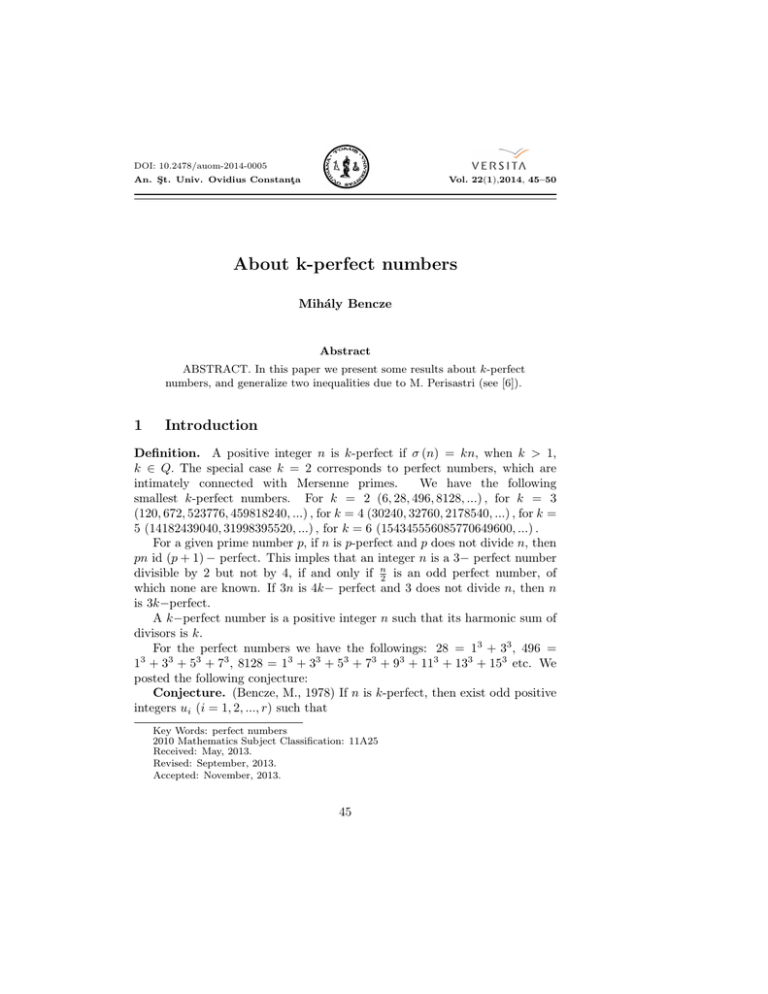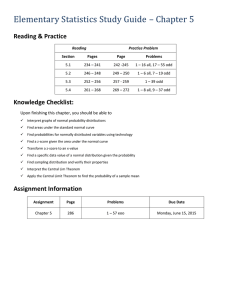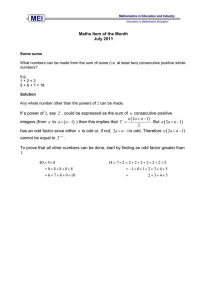About k-perfect numbers Mih´ aly Bencze
advertisement

DOI: 10.2478/auom-2014-0005
An. Şt. Univ. Ovidius Constanţa
Vol. 22(1),2014, 45–50
About k-perfect numbers
Mihály Bencze
Abstract
ABSTRACT. In this paper we present some results about k-perfect
numbers, and generalize two inequalities due to M. Perisastri (see [6]).
1
Introduction
Definition. A positive integer n is k-perfect if σ (n) = kn, when k > 1,
k ∈ Q. The special case k = 2 corresponds to perfect numbers, which are
intimately connected with Mersenne primes.
We have the following
smallest k-perfect numbers. For k = 2 (6, 28, 496, 8128, ...) , for k = 3
(120, 672, 523776, 459818240, ...) , for k = 4 (30240, 32760, 2178540, ...) , for k =
5 (14182439040, 31998395520, ...) , for k = 6 (154345556085770649600, ...) .
For a given prime number p, if n is p-perfect and p does not divide n, then
pn id (p + 1) − perfect. This imples that an integer n is a 3− perfect number
divisible by 2 but not by 4, if and only if n2 is an odd perfect number, of
which none are known. If 3n is 4k− perfect and 3 does not divide n, then n
is 3k−perfect.
A k−perfect number is a positive integer n such that its harmonic sum of
divisors is k.
For the perfect numbers we have the followings: 28 = 13 + 33 , 496 =
13 + 33 + 53 + 73 , 8128 = 13 + 33 + 53 + 73 + 93 + 113 + 133 + 153 etc. We
posted the following conjecture:
Conjecture. (Bencze, M., 1978) If n is k-perfect, then exist odd positive
integers ui (i = 1, 2, ..., r) such that
Key Words: perfect numbers
2010 Mathematics Subject Classification: 11A25
Received: May, 2013.
Revised: September, 2013.
Accepted: November, 2013.
45
46
Mihály Bencze
n=
r
X
uk+1
i
i=1
MAIN RESULTS
αn
1 α2
Theorem 1. If f : R → R is convex and increasing, N = pα
1 p2 ...pn
written in cannonical form is k-perfect, then:
q
n
n 3
X
−1
if
nf
1
2
√
≥
f
3n
nf
pi
k2 − 1
if
i=1
N
is even
N
is odd
Proof. If N is even then it follows
n
Y
pi + 1
i=1
For x ≥ 3 holds
x+1
x
≥
r
3
n
Y
pi + 1
pi
i=1
x
x−1
2
pi
>
3
2
(see [9]), therefore if N is odd then yields
v
u n 2 √
uY
pi
3
3
> k2
>t
p
−
1
i
i=1
because
n
Y
n
i +1
Y
pi
pα
i
>k
=k
p −1
pαi +1 − 1
i=1 i
i=1 i
Using the AM-GM inequality we obtain:
n
Y
pi + 1
i=1
pi
n
≤
1 X pi + 1
n i=1 pi
!n
n
=
1X 1
1+
n i=1 pi
!n
Finally
q
n
n n 3 −1
X
1
2
√
>
n 3n k 2 − 1
p
i
i=1
if N
is even
if N
is odd
Because f is convex and increasing from Jensen’s inequality we get
47
About k-perfect numbers
n
X
1
f
≥ nf
pi
i=1
n
1X 1
n i=1 pi
!
q
nf n 3 − 1
if
√2
≥
3n
nf
k2 − 1
if
N
is even
N
is odd
(1)
αn
1 α2
Theorem 2. If g : R → R is convex and increasing, N = pα
1 p2 ...pn
written in cannonical form is k-perfect, then:
q
6
n
n
X
ng
1
−
if N is even
2
1
q kπ g
≤
ng 1 − n 8 2
pi
if N is odd
i=1
kπ
Proof. We have the following:
j
n
n
n
n
∞ αi +1
i +1
Y
Y
Y
Y
X
pi
pα
−
1
p
1
1
i
i
≤
=
=k
=k
αi
1
αi +1
p
−
1
(p
−
1)
p
p
1
−
p
−
1
i
i
i
α
+1
i
i
i=1
i=1
i=1 i
i=1
i=1
j=0
p
n
Y
i
∞
P
1
∞
k
X
n2
1
n=1
≤k
<
∞
P
2j
1
k
i=1
j=0 pi
(2n+1)2
n
Y
if N
is even
(
=
if N
is odd
kπ 2
6
kπ 2
8
if
if
n=0
From AM-GM inequality yields
n
n
n
Y
n
pi
=
≥
n
P pi −1
p −1
i=1 i
i=1
pi
n−
n
n
P
i=1
1
pi
therefore
q
n
n 1 − n 62
X
1
q kπ <
n 1 − n 82
p
i
i=1
kπ
if N
is even
if N
is odd
According to Jensen’s inequality yields
n
X
1
g
≤ ng
pi
i=1
n
1X 1
n i=1 pi
!
q
ng 1 − n 6 2
kπ
q
≤
ng 1 − n 8 2
kπ
if N
is even
if N
is odd
N
N
is even
is odd
48
Mihály Bencze
αn
1 α2
Corolloary 1. If N = pα
1 p2 ...pn written in cannonical form is k-perfect
then:
q
n n 3 −1
if N
√2
3n
n
k2 − 1
if N
is even
is odd
q
6
n
n
X
if N
n
1
−
2
1
q kπ <
<
n 1 − n 82
p
if N
i=1 i
kπ
is even
is odd
Theorem 3. If x, t > 0 then
1
1
(x + 1) t x+1 − xt x ≤ 1
Proof. For t = 1 we have the equality. Let 0 < t < 1. Since the function
1
u (x) = xt x is continuous and differentiable we can apply the Lagrange’s
theorem and we obtain
1
1
(x + 1) t x+1 − xt x
u (x + 1) − u (x)
=
= u0 (z)
(x + 1) − x
(x + 1) − x
when x < z < x + 1 hence we have the inequality
1
1
1
1
t z 1 − ln t < 1 or 1 − ln t < t− z .
z
z
1
Developing t− z into McLauren’s series it results
1−
1
1
1
1
ln t < 1 −
ln t +
ln2 t −
ln3 t + ...
z
1!z
2!z 2
3!z 3
or
∞
r
X
(−1) lnr t
r=2
r!z r
> 0 or
∞
X
lnr
r=2
1
t
r!z t
>0
that is obvious because ln 1t > 0 due to 1t > 1. Let be t > 1. Then is
1
enough to show that the function V (x) = x t x − 1 is decreasing.
Differentiable V we get
∞
X
1
lnr t
1
V (x) = t − t · ln t − 1 = −
1−
<0
x
xr (r − 1)!
r
r=2
0
1
x
1
x
Since V is decreasing and we may say that V (x + 1) < V (x) hence and
from it follows the inequality of the ennunciation.
αn
1 α2
Corollary 2. If N = pα
1 p2 ...pn is a k-perfect number written in cannonical form, then:
49
About k-perfect numbers
ln 32
2
3 ln k
if N
if N
n
X 1
is even
<
<
is odd
pi
(
i=1
2
ln kπ6
2
ln kπ8
if N
if N
is even
is odd
Proof. Using the Theorem 3 it is proved that the series
!!
r
√
3n
n 3
and n
k2 − 1
n
−1
2
n∈N ∗
∗
n∈N
are decreasing, and the series
!!
r
6
n
n 1−
kπ 2
r
and
n 1−
n∈N ∗
n
8
kπ 2
!!
n∈N ∗
are increasing. It means that the minimum and maximum are reached only
then n → ∞.
Since n → ∞ we have 0 · ∞. That is why L’Hospital rule and so we find
the results of the enunciation.
Remark 1. For k = 2 we reobtain the M.Perisastri’s inequality
n
X
1
π
< 2 ln
p
2
i=1 i
(see [6]).
αn
1 α2
Corollary 3. Let N = pα
1 p2 ...pn be a k−perfect number written in
cannonical form and Pmax = {p1 , p2 , ..., pn } and Pmin = min {p1 , p2 , ..., pn } ,
then
(
1
√
if N is even
n 3
2 −1
Pmin <
1
√
if N is odd
3n
2
k −1
and
Pmax >
1−
1−
1
q
n
1
q
n
6
kπ 2
8
kπ 2
if N
is even
if N
is odd
Proof. Considering that
n
Pmax
<
n
n
X
X
1
1
n
respective
<
p
p
Pmin
i=1 i
i=1 i
from the theorem if follows the affirmation.
50
Mihály Bencze
αn
1 α2
Remark 2. Let N = pα
1 p2 ...pn be a k-perfect number written in cannonical form, then
2n
+2
k2 − 1
(see the method of M. Perisastri’s)
Acknowledgements. The author wishes to express his gratitude to the Organizing Committee of the workshop ”Workshop on Algebraic and Analytic
Number Theory and their Applications” (PN-II-ID-WE - 2012 - 4 -161). The
publication of this paper is supported by the grant of CNCS-UEFISCDI (Romanian National Authority for Scientific Research): PN-II-ID-WE - 2012 - 4
-161.
Pmin <
References
[1] B. Apostol, Extremal orders of some functions connected to regular integers modulo n, An. St. Univ. Ovidius Constanta, Vol. 21(2),2013, 5-19.
[2] M. Bencze, On perfect numbers, Studia Mathematica, Univ. BabesBolyai, Nr. 4, 1981, 14-18.
[3] G. Hardy, D.E. Littlewood, G. Polya, Inequalities, Cambridge, University
Press, 1964.
[4] H.J. Kanold, Über mehrfach volkommene Zahlen, II. J. Reine Angew.
Math., 1957, 197, 82-96.
[5] Octogon Mathematical Magazine (1993-2013).
[6] M. Perisastri, A note on odd perfect numbers, The Mathematics Student
26(1958), 179-181.
[7] J. Sándor, B. Cristici, eds.: Handbook of number theory II, Dordrecht,
Kluwer Academic, 2004.
[8] W. Sierpinski, Elementary theory of numbers, Warsawa, 1964.
[9] The American Mathematical Monthly, E.2308(1971), E.2162(1969)
(Simeon Reich’s note).
Mihály Bencze,
Str. Hărmanului 6,,
505600 Săcele-Négyfalu, Jud. Braşov, Romania
Email: benczemihaly@gmail.com
![ )] (](http://s2.studylib.net/store/data/010418727_1-2ddbdc186ff9d2c5fc7c7eee22be7791-300x300.png)





